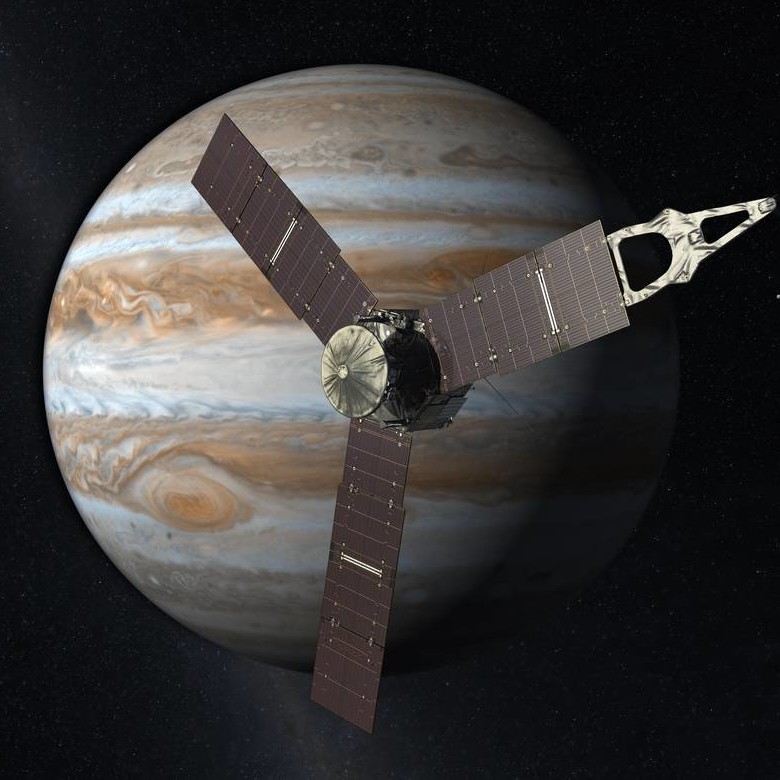The Juno Waves instruments detect electric and magnetic components of plasma waves and radio waves that range through frequencies that include those audible to humans. Although these differ from the pressure waves that we normally think of as sound, they can be used to drive speakers and produce sounds we can hear.
Contact: William Kurth.
Featured Juno Audio
 Play audio (12 seconds)
Play audio (12 seconds)
Juno Waves Audio from Europa Flyby
On September 29, 2022, NASA's Juno spacecraft made a close flyby of Jupiter's icy moon Europa, at a distance of approximately 218 miles (350 kilometers). With a relative velocity of about 14.7 miles per second (23.6 kilometers per second), the Juno spacecraft only had a few minutes to collect data and images during its close flyby of Europa.
In this video, measurements by Juno's Waves instrument during the flyby have been converted to an audible frequency. As the white line moves across the spectrogram, which is a visual way of representing signal strength over time, one can hear the variation of frequency of the plasma waves observed near Europa as the plasma density varies. The video shows data collected over approximately 1.5 hours during the event. Time is indicated along the x-axis, and is shown in Coordinated Universal Time, which is the world-wide scientific standard of timekeeping.
This video highlights plasma waves observed by the Juno Waves instrument in the frequency range of 50 to 150 kHz. The color display shows amplitudes of electric fields as a function of time and frequency. Warmer colors represent larger amplitudes. The speckles are emissions at a characteristic frequency of a magnetized plasma. Given the magnitude of the magnetic field from the Juno magnetometer, these emissions tell us that the density of plasma near Europa ranged from about 60 to 120 electrons per cubic centimeter, but with a very brief peak near 300 per cubic centimeter right at Juno's closest approach to Europa (at 09:36). This range of densities is similar to those measured by the plasma wave instrument on NASA's Galileo spacecraft, which made several flybys of Europa from 1996 to 2000.
The Waves instrument was designed to help scientists understand the interaction between Jupiter's atmosphere, its magnetic field, its magnetosphere, and to understand Jupiter's auroras. It is designed to detect the electric fields of radio emissions from 50 Hz up to 40,000,000 Hz (40 MHz), and magnetic fields from 50 Hz to 20,000 Hz (20 kHz).
Knowing the plasma density near Europa is important to understanding how Europa interacts with Jupiter's magnetosphere. Jupiter's magnetic field, the largest in the solar system, traps the charged particle gas - plasma - that fills the space surrounding Europa (and the rest of the Jupiter system). As Europa moves in its orbit, the magnetic field varies. Time-variations of the magnetic field induce Europa to produce its own magnetic field that, in turn, can provide clues to the structure of the moon's interior. Knowing the plasma environment near Europa allows for a more accurate measure of this induced field.
The Juno spacecraft, which entered orbit around Jupiter on July 4, 2016, is the first explorer to peer below the planet's dense clouds to answer questions about the gas giant itself and the origins of our solar system. Juno's extended mission began in August 2021, and continues its investigation of the solar system's largest planet through September 2025. This extension tasks Juno with becoming an explorer of the full Jovian system - Jupiter and its rings and moons. The close flyby of Europa in September marks the second encounter with a Galilean moon during Juno's extended mission. The mission explored Ganymede in June 2021 and is scheduled to make close flybys of Io, the most volcanic body in the solar system, in 2023 and 2024.
More information about Juno is at https://www.nasa.gov/juno and https://missionjuno.swri.edu. For more about this finding and other science results, see https://www.missionjuno.swri.edu/science-findings.
Past Featured Audio Clips
- Juno Waves Audio from Europa Flyby
- Musical Tones from Juno Waves Perijove 4
- Juno Listens to Jupiter's Auroras
- Juno Records Jupiter's Bow Shock
- Juno Crosses Jupiter's Magnetopause
 Juno
Waves
Juno
Waves



